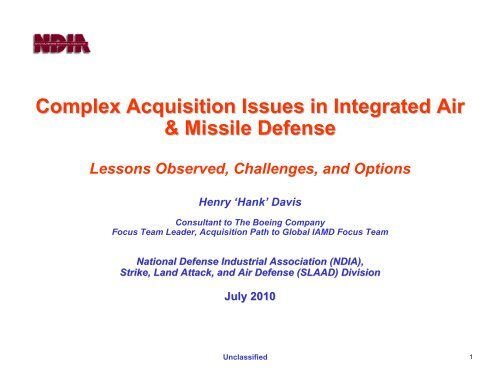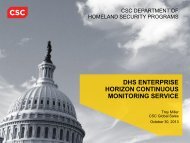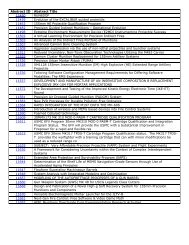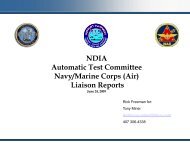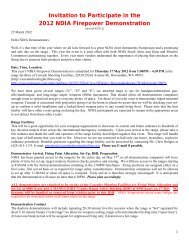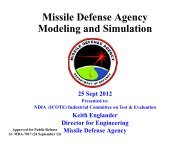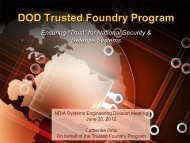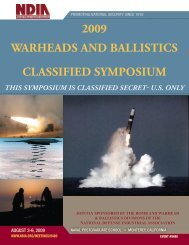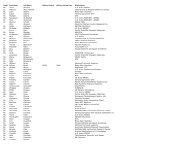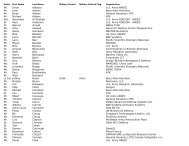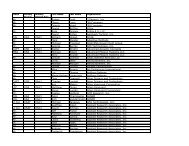Complex Acquisition of IAMD - National Defense Industrial Association
Complex Acquisition of IAMD - National Defense Industrial Association
Complex Acquisition of IAMD - National Defense Industrial Association
You also want an ePaper? Increase the reach of your titles
YUMPU automatically turns print PDFs into web optimized ePapers that Google loves.
<strong>Complex</strong> <strong>Acquisition</strong> Issues in Integrated Air<br />
& Missile <strong>Defense</strong><br />
Lessons Observed, Challenges, and Options<br />
Henry ‘Hank’ Davis<br />
Consultant to The Boeing Company<br />
Focus Team Leader, <strong>Acquisition</strong> Path to Global <strong>IAMD</strong> Focus Team<br />
<strong>National</strong> <strong>Defense</strong> <strong>Industrial</strong> <strong>Association</strong> (NDIA),<br />
Strike, Land Attack, and Air <strong>Defense</strong> (SLAAD) Division<br />
July 2010<br />
Unclassified<br />
1
Global <strong>IAMD</strong> <strong>Acquisition</strong> Focus<br />
Focus Team Task<br />
• From… capability development implications, make specific<br />
recommendations in the related areas <strong>of</strong> requirements for<br />
acquisition alternatives and programmatic risks to leverage the<br />
best <strong>of</strong> industry to develop and integrate (and test) existing and<br />
emerging Joint capabilities into a seamless and flexible Global<br />
<strong>IAMD</strong> capability, including Joint Integrated Fire Control (JIFC)<br />
capabilities<br />
What is an appropriate strategy for successfully acquiring a<br />
Global <strong>IAMD</strong> capability?<br />
Unclassified<br />
2
Global <strong>IAMD</strong><br />
Attributes <strong>of</strong> Joint Integrated Fire Control (IFC)<br />
Integrated Engagement Space • High capacity, high speed, adaptive Battle<br />
Management systems<br />
Geographic Combat Area<br />
Joint IFC, evolving from NIFC-CA concepts,<br />
supports capability to neutralize and mitigate<br />
effects <strong>of</strong> adversaries by destroying air and missile<br />
threats in all domains (air, land, maritime, space,<br />
and cyberspace)<br />
• Globally distributed sensor nets, distributed<br />
weapons platforms<br />
• Weapons matched to sensors and fire control<br />
capabilities<br />
• Interoperable distributed track fusion and ID engines<br />
with automated real-time correlation<br />
• Robust tactical networks with interoperable real-time<br />
data distribution systems<br />
• Modernized Doctrine, Tactics, Techniques and<br />
Procedures to leverage new netted concepts<br />
Unclassified<br />
Joint Engagement Zone (JEZ)<br />
3
Global <strong>IAMD</strong> Capability --- “Window to the Future”<br />
Global <strong>IAMD</strong> capability depends on in-depth transition to a net-centric,<br />
service-oriented architecture “system <strong>of</strong> systems” concept<br />
Unclassified<br />
4
Global <strong>IAMD</strong> Fire Control Network<br />
Finding and Recommendations<br />
Finding --- CEC fire control network architecture alone is insufficient to<br />
provide fire control network for Global-<strong>IAMD</strong> capability.<br />
Recommendations:<br />
• Consider re-partitioning CEC system between the “radio” and the<br />
“processing”… technology has rendered system architecture obsolete.<br />
• Expand program/industry participation to re-architect and upgrade the<br />
“processing” to facilitate integration into a wide variety <strong>of</strong> combat and<br />
sensing systems to support a large scale Joint sensing network for<br />
counter air and ballistic missile battle management & fire control … e.g.<br />
updated network topologies, geodetic referencing, added filters<br />
• Consider providing CEC “radio” element for expanding joint battle<br />
management and command & control connectivity<br />
Joint fire control sensing networks must employ “CEC-like,” composite<br />
tracking capabilities capable <strong>of</strong> handling large numbers <strong>of</strong> network<br />
contributors and very high track loads<br />
Unclassified<br />
5
Tactical Data Links<br />
Finding and Recommendations<br />
Finding: JTIDS/Link-16 has limited capability for Global <strong>IAMD</strong>, including:<br />
– Network architecture not designed for <strong>IAMD</strong> --- adequate for CTP/COP<br />
– Native form has line-<strong>of</strong>-sight limitations --- airborne, point to point<br />
– Track numbers limited<br />
– Insufficient tracks for BM track cluster discrimination<br />
– Latency: limits defended area and available battlespace<br />
– No simultaneous reporting from multiple sensors (R 2 - one per track)<br />
– Inconsistent data interpretations across Services<br />
– System designed as situational awareness system and only works as fire control<br />
against long-range ballistic missiles<br />
– Needs broad digital air control for fighter contributions to <strong>IAMD</strong><br />
Recommendations:<br />
• Assess suitability <strong>of</strong> transformational communications “tactical edge” programs<br />
(Joint Tactical Radio Systems, Wide Band Networks, Link 16 updates) performance<br />
and architectures to handle G-<strong>IAMD</strong> battle management and Joint Integrated Fire<br />
Control demands.<br />
• Assess the forward and backward interoperability with essential existing and<br />
future elements <strong>of</strong> G-<strong>IAMD</strong> battle management and Joint Integrated Fire Control<br />
• Define concepts for employment <strong>of</strong> Link 16 over a CEC-like radio element to<br />
support netted sensors and Joint-Integrated Fire Control.<br />
Unclassified<br />
6
Joint Integrated Air & Missile <strong>Defense</strong><br />
System <strong>of</strong><br />
Systems<br />
Naval Integrated<br />
Fire Control-<br />
Counter Air<br />
Joint<br />
Integrated<br />
Fire Control<br />
Development <strong>of</strong> Global <strong>IAMD</strong> Capability in Joint<br />
Engagement Zones is <strong>Complex</strong> & Highly Interactive<br />
C2-Battle Mgmt Sensors Weapons Networks<br />
• JFMMC-MOC<br />
• Aegis C&D<br />
• E-2D<br />
• E-3 40-45<br />
• 767 AWACS<br />
• GTACS<br />
• BCS-F & M<br />
• Integrated Battle<br />
Command System<br />
• GMD Fire Control<br />
• C2BMC<br />
• Global<br />
Engagement<br />
Manager<br />
• 737 AEW&C<br />
• Others<br />
• SPY<br />
• JLENS<br />
• E-2D Radar<br />
• AWACS Radar<br />
• TPS75<br />
• Sentinel Radar<br />
• AEW&C Radar<br />
• G/ATOR<br />
• Tactical Aircraft<br />
ESAs<br />
• TPY2<br />
• UEWR<br />
• Cobra Dane<br />
• Cobra Judy<br />
• SBX<br />
• SBIRS<br />
• DSP<br />
• <strong>National</strong> Sensors<br />
• DCGS<br />
• ACIP-NEXTGEN ISR<br />
• Single Integrated<br />
Pictures ?<br />
• Others<br />
• SM-6<br />
• Patriot<br />
• Tactical<br />
Fighters<br />
• Advanced AA<br />
Missiles<br />
• THAAD<br />
• GBI<br />
• ABL<br />
• SLAAMRAAM<br />
• Others<br />
• CEC-DDS<br />
• JTIDS-<br />
Link 16<br />
• JTRS<br />
• WNW<br />
• GIG-BE<br />
• GCN<br />
• TCN<br />
• WIN-T<br />
• TSAT ?<br />
• NCES<br />
(including<br />
real time<br />
wireless)<br />
• DIB<br />
• Others<br />
Unclassified<br />
Joint Engagement Zone<br />
(JEZ)<br />
Development <strong>of</strong> “large scale system <strong>of</strong> systems” capability demands<br />
robust system <strong>of</strong> systems engineering, integration, test, doctrine and<br />
training development and common networks & communications<br />
7
System <strong>of</strong> System<br />
Definition<br />
System <strong>of</strong> Systems<br />
Engineering<br />
System <strong>of</strong> Systems<br />
Integration &<br />
Acceptance<br />
Systems<br />
Development<br />
What Makes System Of Systems<br />
Development Hard ?<br />
• Mission Description<br />
• Operational Concepts<br />
• Technical Objectives and Goals (TOG)<br />
• Performance Validation<br />
• Evolution Strategy…<br />
• Concept Development<br />
• Trade Studies & Analyses…Performance<br />
& Multi-role Equities<br />
• Functional Allocation to Define System<br />
Capability Specifications<br />
• Verification / Test Objectives<br />
• Engineering Process Control…<br />
• Configuration Management / Control<br />
• Interface Specification & Control<br />
• Performance Assessment (Operational &<br />
Technical) “virtual”<br />
• Integration & Testing<br />
• Doctrine and Training…<br />
• Life Cycle Product Development<br />
• Element Design Specifications & Interface<br />
Control Documents (ICD)<br />
• Hardware and S<strong>of</strong>tware Products<br />
Unclassified<br />
Defining<br />
Objectives<br />
Engineering<br />
Design<br />
Assembling the<br />
System<br />
Building the<br />
Elements<br />
8
Systems <strong>of</strong><br />
Systems<br />
Definition<br />
SoS<br />
Engineering<br />
SoS Integ &<br />
Acceptance<br />
Systems<br />
Development<br />
System <strong>of</strong><br />
Systems<br />
Characteristics<br />
Government<br />
Integrator<br />
Government<br />
FFRDC<br />
Government<br />
&<br />
Independent<br />
Contractor<br />
Associate Contractor<br />
Agreements (ACAs)<br />
Unclassified<br />
SoS <strong>Acquisition</strong> Options<br />
Industry Integrator<br />
Government<br />
FFRDC<br />
Industry Integrator<br />
Industry<br />
Integrator<br />
(Not a Systems<br />
Developer)<br />
Some ACAs<br />
Prime<br />
Contractor<br />
Government<br />
FFRDC<br />
Prime Contractor<br />
CTR CTR CTR CTR CTR CTR CTR CTR CTR<br />
Highly Interactive,<br />
With Moderate<br />
Elements<br />
Large, Highly Interactive,<br />
Multi-role With Many<br />
Elements<br />
Prime<br />
Contractor<br />
Some ACAs<br />
Well Defined &<br />
Contained With Few<br />
Elements<br />
Allocation <strong>of</strong> tasks & accountabilities between Government,<br />
FFRDCs, Integrator/Prime and Independent Contractors define<br />
spectrum <strong>of</strong> different acquisition strategies & associated risks<br />
9
Emerging “1 st Principles” <strong>of</strong> Successful<br />
Large-Scale Development Programs<br />
• Requirements<br />
– Warfighter involvement institutionalized in acquisition strategy --- from concept thru development<br />
– Transition from operational views to system <strong>of</strong> systems views --- the first 10% <strong>of</strong> development is<br />
critical to success --- must involve large scale integrators.<br />
– Set only top level performance specs (KPPs) and use large scale integrator to flow down to<br />
procurement<br />
• <strong>Acquisition</strong> Strategy<br />
– Program structure & reporting level must reflect priority <strong>of</strong> development<br />
– Clear responsibility, accountability, authority and resolve charter issues as a team.<br />
– Continuous and open communications to give full insight into program health<br />
– Large scale integrator must account for system requirements & interfaces and define test &<br />
acceptance <strong>of</strong> elements.<br />
– SOS developments are long and complex, spirals and concurrency are required & funded<br />
• Architectures<br />
– Must drive the acquisition strategy to keep management and business relationships clear.<br />
– Involve thousands <strong>of</strong> elements and millions <strong>of</strong> interface requirements<br />
– Use net-centric and service oriented to enhance competitive incentives across system <strong>of</strong> systems<br />
• Business Models<br />
– Architecture will drive the business models --- supplier management is most critical element<br />
– Government and industry team must have highly competent and proven program & technical<br />
leadership --- growing demographic challenges.<br />
– Integrator award fees must be sufficiently high to attract qualified integration companies<br />
– Large scale integrator business models must transform during acquisition cycle<br />
Integrated capability developments are “game changers” in<br />
government requirements/acquisition and industry cultures<br />
Unclassified<br />
10
Global <strong>IAMD</strong> <strong>Acquisition</strong> Alternatives<br />
Finding and Recommendations<br />
Finding --- Large, complex integrated capability acquisitions challenge<br />
both government & industry management culture and business models!<br />
Recommendations:<br />
• Propose a Global <strong>IAMD</strong> acquisition charter at Joint/OSD level…change<br />
to capability based acquisition<br />
• Broaden industry involvement to create government/industry teams by<br />
competing and awarding multiple contracts to develop a range <strong>of</strong><br />
innovative Global <strong>IAMD</strong> architectural and acquisition strategies<br />
Global <strong>IAMD</strong> acquisition strategy must leverage technology, program,<br />
contracting, and business innovation from across industry and<br />
FFRDC/UARC communities<br />
Unclassified<br />
11
Unclassified<br />
Backup Slides<br />
12
Global <strong>IAMD</strong> System Assessment<br />
Finding and Recommendations<br />
• Finding: There is no established real-time capability to assess performance<br />
<strong>of</strong> BMD systems and interceptors in real-world tactical operations<br />
Recommendations:<br />
• Define requirements for “real-time assessment” <strong>of</strong> tactical BMD system<br />
performance to enable rapid system updates:<br />
– Data collection needs and concepts<br />
– System fix concepts…eventually a real-time capability<br />
• Work with MDA to establish BMD Battlefield Learning Group for BMD analysis<br />
support:<br />
– Pull technical expertise from MDA, service warfighters, FFRDCs, labs,<br />
industry, and other stakeholders<br />
– Integrate into planned test shots and operational testing to refine<br />
requirements<br />
Early fielding <strong>of</strong> Fleet BMD capability will reveal many unknown<br />
performance risks…first shots in “anger” may miss!<br />
Unclassified<br />
13
Large-Scale Capabilities <strong>Acquisition</strong><br />
“Lessons Observed ‘Gurus’ ”<br />
• Dennis Gormley… Monterey Institute, International Institute for Strategic Studies, Rand,<br />
Pacific Sierra …Thought Leader in DoD policy changes since emergence <strong>of</strong> mass missile<br />
threats<br />
– Author <strong>of</strong> “Missile Contagion” … thesis: “…we are at a tipping point from missile threats, across<br />
strategic to tactical levels.”<br />
• Dr. Allen Adler… former DARPA executive… development <strong>of</strong> Future Combat Systems<br />
acquisition and system <strong>of</strong> systems engineering processes<br />
– System <strong>of</strong> Systems engineering & acquisition approach essential to successful large-scale<br />
capability integration<br />
• Dr. John Peller… former Rockwell-Boeing executive…Large scale capability<br />
developments from Minuteman ICBMs to Missile <strong>Defense</strong> to Future Combat Systems<br />
– Net-centric capabilities are acquisition “game changers” for Government and Industry<br />
• David Kier… formerly Deputy NRO, Government PM for Special Programs, Lockheed PM<br />
for <strong>National</strong> Team for C2BMC<br />
– Risk management must span from requirements definition thru acquisition and acceptance<br />
– Integrator business incentives are essential to bring the right industry capability to the table<br />
• Dr. Jerry Augeri… Lincoln Labs involved in development and fielding <strong>of</strong> <strong>National</strong> Capital<br />
Region IADS<br />
– Global Sensor Integration Network Concepts … Advanced Service-Oriented network architectures<br />
Unclassified<br />
14
Unclassified<br />
Thoughts on a Global <strong>IAMD</strong><br />
<strong>Acquisition</strong> Strategy<br />
• Unify tactical requirements ... Using broad area announcements to<br />
develop system architectures and cost estimations<br />
– Create an “outside the box” Government (DARPA-War fighter?)-Industry team to<br />
work Joint system <strong>of</strong> systems requirements development with industry --- Move<br />
J<strong>IAMD</strong>O Operational Views to System Views to underpin acquisition strategy.<br />
– Focus on system <strong>of</strong> systems architecture and integration <strong>of</strong> existing and<br />
emerging systems<br />
• Use system <strong>of</strong> systems architectural elements and networks to drive<br />
programs toward integration<br />
– Define joint track manager and networks for surveillance and precision tracking<br />
– Architect battle command in JEZ built upon NIFC-CA “concept” to merge ballistic<br />
missile defenses with air defenses, to include defensive counter-air<br />
– Focus on integration <strong>of</strong> space and airborne sensors for elevation and overlapping<br />
sensor coverage<br />
– Define integrated tactical architecture for Global <strong>IAMD</strong> to include warfighting and<br />
planning elements<br />
• Phase delivery <strong>of</strong> global <strong>IAMD</strong> capability to warfighters<br />
– Consider regional and cross-AOR requirements and policy implications<br />
15
N2/N6 & N8 Realignment<br />
Findings and Recommendation<br />
Finding: N2/N6 and N8 realignment emphasizes “information” and<br />
“user integration”<br />
Recommendations:<br />
• Charter a robust net-centric system <strong>of</strong> systems engineering and integration<br />
capability to integrate warfighters into requirements development & analysis and<br />
program definition…Consider significant competitive use <strong>of</strong> world-class<br />
industry, FFRDC/UARC capabilities.<br />
• Focus on “force-level systems engineering” <strong>of</strong> requirements by using<br />
collaboratively developed mission threads/kill chains and design reference<br />
missions employing warfighter in the loop simulations.<br />
• Take deliberate action to mitigate risks to integration <strong>of</strong> ISR-SA and Integrated<br />
Fire Control initiatives critical to Global <strong>IAMD</strong><br />
Navy staff realignment presents significant opportunity to transition to<br />
capability based acquisitions<br />
Unclassified<br />
16
Global <strong>IAMD</strong> Technical Architecture<br />
Finding and Recommendations<br />
Finding --- “Open standards” requires redefinition --- Integration must occur<br />
at the data level, across large, ad hoc, tactical, real-time wireless networks<br />
Recommendations:<br />
• Use Global <strong>IAMD</strong> capability development to enable information sharing<br />
and interoperability environment<br />
• Open existing weapons systems for integration into the Global <strong>IAMD</strong><br />
network<br />
• Follow commercial development <strong>of</strong> wired and wireless network standards<br />
… they are making the investment<br />
• Define systems as data centric…information exchange must handle many<br />
contributors and users that will not have common systems<br />
• Use commercial tools where timing, information assurance and data<br />
integrity allow<br />
• Reemphasize architecture education and training to transition to net<br />
centric systems engineering<br />
Integration across a tactical, ad hoc, wireless warfighting network demands<br />
advanced net-centric engineering far beyond “open architecture” s<strong>of</strong>tware<br />
development concepts<br />
Unclassified<br />
17
Global <strong>IAMD</strong> Network Imperatives<br />
Finding --- Communications challenged/bandwidth limited environments<br />
demand robust, secure and adaptive quality <strong>of</strong> service to meet timeliness<br />
requirements in large scale network tactical operations<br />
• Real-time execution<br />
• Broad reach<br />
• Rapid updates<br />
• Secure<br />
• Cyber hardened<br />
• other<br />
Recommendations:<br />
Establish Government/Industry partnership in open network architecture,<br />
collaborative development, including<br />
– Interoperability services<br />
– Adaptive communication services (QoS)<br />
– Integral information assurance & cyber security<br />
• Develop solutions using advanced network technologies that resolve scaling<br />
and security concerns<br />
Unclassified<br />
18
Unclassified<br />
Global <strong>IAMD</strong><br />
Current <strong>Acquisition</strong> State<br />
Finding --- Current integrated capability roadmaps lack sufficiently well<br />
defined and enforced “Global <strong>IAMD</strong> objective architectural” concept<br />
alternatives<br />
• Joint capability architectural and systems requirements trades don’t drive sensor,<br />
weapons and network alternative trades<br />
•“Advanced Concept Demonstrations” do not transition well to integrated capability<br />
acquisitions<br />
Recommendations:<br />
• Broaden acquisition concept from just “sensors on weapons platforms” to<br />
advanced concepts <strong>of</strong> distributed sensor & weapons “server” networks…surface,<br />
air & space, and advanced “ad hoc battle management /command concepts”<br />
• Define requirements for G-<strong>IAMD</strong> system architectures to enable advanced<br />
capability… from strategic, operational and tactical to fire control in one<br />
architecture<br />
• Architect netted weapons-sensor systems to match track performance with<br />
accuracy requirements <strong>of</strong> a wide variety <strong>of</strong> weapons, fire control systems, and<br />
decision makers across the war fighting net<br />
• Scale existing netted sensor architecture to Joint capability<br />
• Define interoperability and data sharing requirements for existing programs<br />
sufficient to deliver integrated warfare capability<br />
19
Thoughts on Global <strong>IAMD</strong> <strong>Acquisition</strong><br />
Leadership & Organization<br />
• Responsibility (Ownership…job description)<br />
– Define G<strong>IAMD</strong> System <strong>of</strong> Systems system architectures to meet capability<br />
required to execute essential mission threads (kill chains)<br />
– Define and implement architecturally focused acquisition strategy<br />
• Accountability (Delivery)<br />
– Report to sufficiently high level acquisition authority<br />
– System <strong>of</strong> System Architecture definition and existing element interface<br />
requirements<br />
– Program and capability deliverables and schedules<br />
– Element acquisition strategies and implementation<br />
– Associate program agreements<br />
– Technology insertion strategies<br />
• authority (Funding)<br />
– Funding control <strong>of</strong> critical path architectural elements<br />
– Element acquisition decisions where appropriate<br />
– Reserve to handle concurrent developments where required to meet<br />
incremental capability deliveries<br />
– Must recognize service multi-role equity concerns<br />
A single acquisition organization with Responsibility, Accountability, and<br />
authority (RAa) for complex acquisitions across Global-<strong>IAMD</strong> reduces risk.<br />
Unclassified<br />
20


